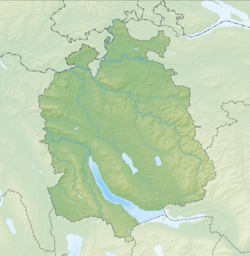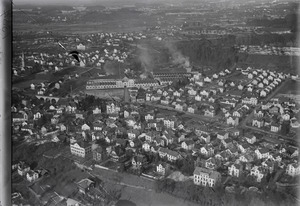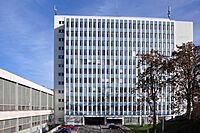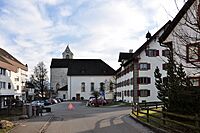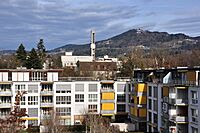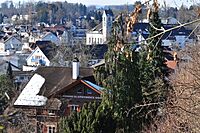Rüti, Zürich facts for kids
Quick facts for kids
Rüti
|
||
|---|---|---|
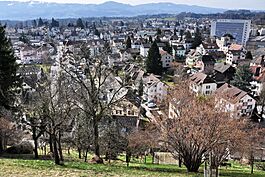 |
||
|
||
| Country | Switzerland | |
| Canton | Zürich | |
| District | Hinwil | |
| Area | ||
| • Total | 10.06 km2 (3.88 sq mi) | |
| Elevation
(Bahnhof)
|
482 m (1,581 ft) | |
| Population
(Dec 2020 )
|
||
| • Total | 12,494 | |
| • Density | 1,241.9/km2 (3,216.6/sq mi) | |
| Postal code |
8630
|
|
| Localities | Weid, Moos, Weier and Fägswil | |
| Surrounded by | Bubikon, Dürnten-Tann, Eschenbach (SG), Rapperswil-Jona (SG), Wald | |
Rüti, sometimes called Rüti ZH to tell it apart from other places with the same name, is a town in Switzerland. It is a municipality located in the district of Hinwil in the canton of Zürich. The Jona River flows right through the town.
Contents
Rüti's Past: A Look at Its History
People likely started living in the Rüti area around the 8th and 9th centuries. In 807, a part of Rüti called Fägswil was first mentioned in a document from the Abbey of Saint Gall. Later, in 972, a document from Emperor Otto II called the area Riutun. This Old High German word means "to clear forest for farming," which is how the name Rüti came about.
In 1206, the Rüti Monastery was founded by Lütold IV, Duke of Regensberg. The building that is now the Reformed church was finished in 1283. In 1408, Rüti and its monastery became part of the Herrschaft Grüningen, which was controlled by the government of Zürich. In 1525, during the Reformation in Zürich, the monastery was taken over by the government and managed by an Amtmann (a government official) until 1798.
In the mid-16th century, Rüti opened one of the first public schools in the canton of Zürich. This school was started by the Zürich reformers and the former monks of the Rüti Monastery. In 1866, the first Catholic Mass was held in the Zürcher Oberland region after the Reformation. A Catholic church was built in Tann ZH (which is part of the Dürnten municipality) in 1963.
Rüti's economy really grew when the Industrial Revolution began in the 19th century. In 1833, Rüti was connected to the main road network. Then, in 1859, a railway line connecting Zürich, Uster, and Rapperswil reached the town. This railway was made electric in 1932 and became part of the Zurich S-Bahn train system in 1990.
In 2007, Rüti celebrated its 1200th anniversary with many special events and festivals.
Rüti's Location and Landscape
Rüti covers an area of about 10.06 square kilometers (3.88 square miles). A little over one-third of this land (36.4%) is used for farming, and another third (35.4%) is covered by forests. About 26.9% of the land is developed with buildings and roads, while the remaining 1.4% includes rivers and other natural areas.
The town is located where two rivers, the Jona and the Schwarz, meet. It also includes smaller areas called Weid, Moos, Weier, and Fägswil. Rüti grew up around the Rüti Monastery, which was built near a bridge on a pilgrimage route to Einsiedeln Abbey.
Rüti's Economy and Jobs
Since the Middle Ages, the power of the Jona River's water was used to run watermills. Later, this hydropower was used for textile factories. In the early 19th century, Rüti became an important center for industrialization in southeastern Zürich.
In 1847, a company called Caspar Honegger started making weaving machines in the Joweid valley. This company later became Maschinenfabrik Rüti AG and was known worldwide. In the 1990s, it became part of larger groups like Sulzer. Today, you can see a collection of weaving machines made by this company in a museum in nearby Neuthal.
The Rüti hospital was built in 1875, but it closed in 2000. Today, the buildings of the former hospital are used as a recruitment center for the Swiss Army and civil defense for several cantons. Rüti also has nine school buildings and many shopping areas.
Rüti has a low unemployment rate of 2.77%. Many people work in different types of jobs:
- Primary sector: About 106 people work in farming and related businesses.
- Secondary sector: Around 1532 people work in manufacturing and industry.
- Tertiary sector: About 2431 people work in services, like shops, offices, and healthcare.
Most working people in Rüti (40%) have full-time jobs, while 60% work part-time.
People of Rüti: Demographics and Culture
Rüti has a population of 12,494. About 21% of the people living in Rüti are foreign nationals. The population has grown by about 7.4% in the last 10 years.
Most people in Rüti (85.5%) speak German. Italian is the second most common language (4.6%), followed by Serbo-Croatian (2.0%).
In the 2007 election, the most popular political party was the SVP, which received 36.1% of the votes. Other popular parties included the SPS (16.9%) and the CVP (12.2%).
When it comes to age, about 23.8% of Rüti's population are children and teenagers (0–19 years old). Adults (20–64 years old) make up 61.5%, and seniors (over 64 years old) make up 14.7%. Most adults in Rüti (about 69.9%) have completed higher education, like university or a specialized college. There are 4691 households in Rüti.
In 2008, there were 3871 Catholics and 4102 Protestants in Rüti. In the 2000 census, about 41.5% of the population were Protestant, with most belonging to the Swiss Reformed Church. About 35.6% of the population were Catholic. Other religions, or no religion, made up the rest.
Getting Around: Transport in Rüti
In 1833, Rüti was connected to the main cantonal road system. Since the 1980s, this has included the Oberland Autobahn, which is the A53 highway.
In 1859, the railway line connecting Zürich to Rapperswil was built. This line was electrified in 1932 and is now part of the S-Bahn Zürich commuter train network. The Rüti ZH railway station is a stop for the S15 and S5 lines. A train ride from Rüti to Zürich Hauptbahnhof (Zurich Main Station) takes about 28 minutes on the S5 line. The Tösstalbahn (S-Bahn Zürich line S26) also ends in Rüti.
Sports in Rüti
Rüti has its own football club called Fussball Club Rüti. It was founded in 1930 and plays at the Schützenwiese stadium, which was built in 1956. As of the 2019–20 season, the club plays in the 2. Liga Interregional Group 6, which is the fifth level of football in Switzerland.
Rüti Today
Rüti's population reached over 10,000 people for the first time in 1971/1972. Today, Rüti has many clubs, a local museum, a library, and a historical society. In 2007, the town celebrated its 1200th birthday with various events and festivals.
Notable People from Rüti
- Albin Zollinger (1895–1941) – A Swiss writer who grew up in Rüti.
- Albert Zweifel (born 1949 in Rüti) – A former professional cyclo-cross cyclist.
- Monika Rieder (born 1974 in Rüti) – A Swiss sport shooter who competed in the 2004 Summer Olympics.
- Enrico De Maria (born 1976 in Rüti) – A Swiss Olympic Star class sailor who competed in the 2004, 2008, and 2012 Summer Olympics.
See also
 In Spanish: Rüti (Zúrich) para niños
In Spanish: Rüti (Zúrich) para niños




